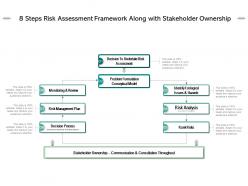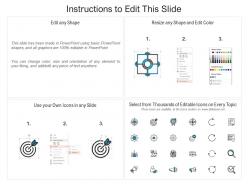8 steps risk assessment framework along with stakeholder ownership
Follow a detailed chart with our 8 Steps Risk Assessment Framework Along With Stakeholder Ownership. They help you chalk out the future.
- Google Slides is a new FREE Presentation software from Google.
- All our content is 100% compatible with Google Slides.
- Just download our designs, and upload them to Google Slides and they will work automatically.
- Amaze your audience with SlideTeam and Google Slides.
-
Want Changes to This PPT Slide? Check out our Presentation Design Services
- WideScreen Aspect ratio is becoming a very popular format. When you download this product, the downloaded ZIP will contain this product in both standard and widescreen format.
-

- Some older products that we have may only be in standard format, but they can easily be converted to widescreen.
- To do this, please open the SlideTeam product in Powerpoint, and go to
- Design ( On the top bar) -> Page Setup -> and select "On-screen Show (16:9)” in the drop down for "Slides Sized for".
- The slide or theme will change to widescreen, and all graphics will adjust automatically. You can similarly convert our content to any other desired screen aspect ratio.
Compatible With Google Slides

Get This In WideScreen
You must be logged in to download this presentation.
PowerPoint presentation slides
Presenting this set of slides with name 8 Steps Risk Assessment Framework Along With Stakeholder Ownership. This is a eight stage process. The stages in this process are Risk Assessment, Process, Business Risk. This is a completely editable PowerPoint presentation and is available for immediate download. Download now and impress your audience.
Content of this Powerpoint Presentation
Description:
The image presents an "8 Steps Risk Assessment Framework" along with a focus on Stakeholder Ownership, highlighting the importance of communication and consultation throughout the risk assessment process. This comprehensive framework serves as an organizational tool for effectively managing risks within various project or business operation contexts.
Here is an overview of each step in the 8 Steps Risk Assessment Framework:
1. Decision To Undertake Risk Assessment (Step 1):
The initial step involves making a conscious decision to initiate a risk assessment, indicating the acknowledgment of potential risks within a project or environment.
2. Problem Formulation Conceptual Model (Step 2):
At this stage, issues are identified, and a conceptual model is created to gain a deeper understanding of the problems, laying the foundation for further analysis.
3. Identify Ecological Issues & Hazards (Step 3):
This step is specifically focused on identifying potential environmental impacts, requiring a detailed examination of ecological concerns that may arise during a project's lifecycle.
4. Risk Analysis (Step 4):
In this stage, a thorough analysis of the identified risks is conducted to comprehend their likelihood and potential impact.
5. Rank Risks (Step 5):
Based on the analysis, risks are then ranked according to their severity, urgency, or importance, helping prioritize risk management efforts.
6. Decision Process (Step 6):
This step involves evaluating alternatives and selecting the most suitable risk management options or responses.
7. Risk Management Plan (Step 7):
Here, a strategic plan is developed to address and mitigate the prioritized risks effectively.
8. Monitoring & Review (Step 8):
Finally, ongoing monitoring and review processes are implemented to ensure the risk management plan remains effective and is adjusted as necessary.
Use Cases:
This versatile framework can be applied to various industries where risk assessment and stakeholder engagement are critical for success. Here are potential applications of this framework in different industries:
1. Finance:
Use: Managing financial risks effectively.
Presenter: Risk Manager.
Audience: Financial Analysts.
2. Healthcare:
Use: Assessing and managing patient safety and compliance risks.
Presenter: Healthcare Administrator.
Audience: Medical Staff.
3. Construction:
Use: Assessing and mitigating risks related to construction projects.
Presenter: Project Manager.
Audience: Construction Engineers and Safety Inspectors.
4. Information Technology:
Use: Ensuring cybersecurity and managing IT project risks.
Presenter: IT Risk Analyst.
Audience: IT Professionals and Stakeholders.
5. Manufacturing:
Use: Proactively addressing risks in manufacturing processes and supply chains.
Presenter: Operations Manager.
Audience: Production Team and Quality Control Specialists.
6. Education:
Use: Developing risk management strategies in educational programs and ensuring campus safety.
Presenter: School Administrator.
Audience: Teachers and School Board Members.
7. Environmental Management:
Use: Managing ecological risks and ensuring sustainable project outcomes.
Presenter: Environmental Consultant.
Audience: Project Developers and Environmental Scientists.
8 steps risk assessment framework along with stakeholder ownership with all 2 slides:
Development evolves with our 8 Steps Risk Assessment Framework Along With Stakeholder Ownership. The course to follow begins to emerge.
No Reviews












